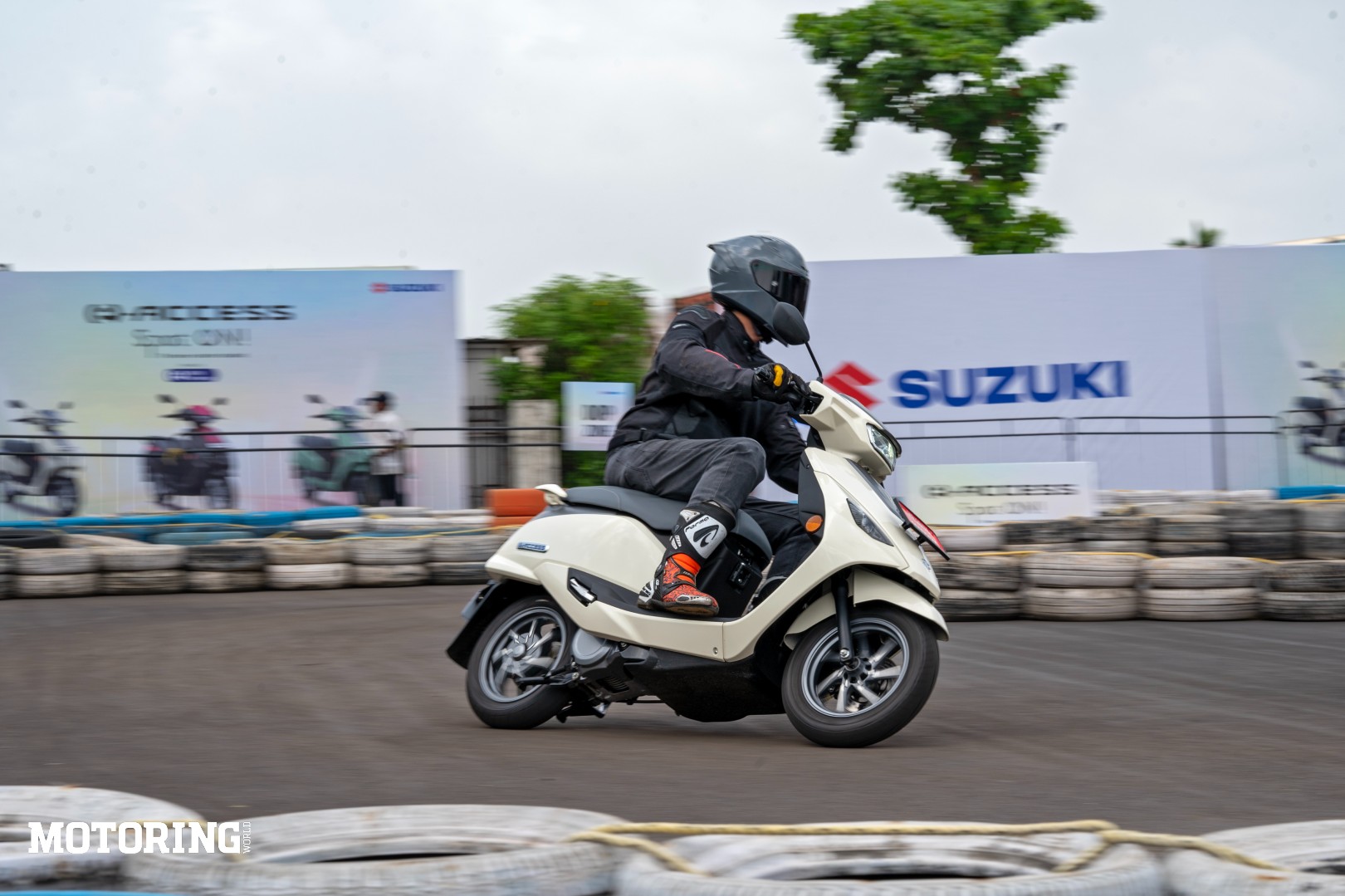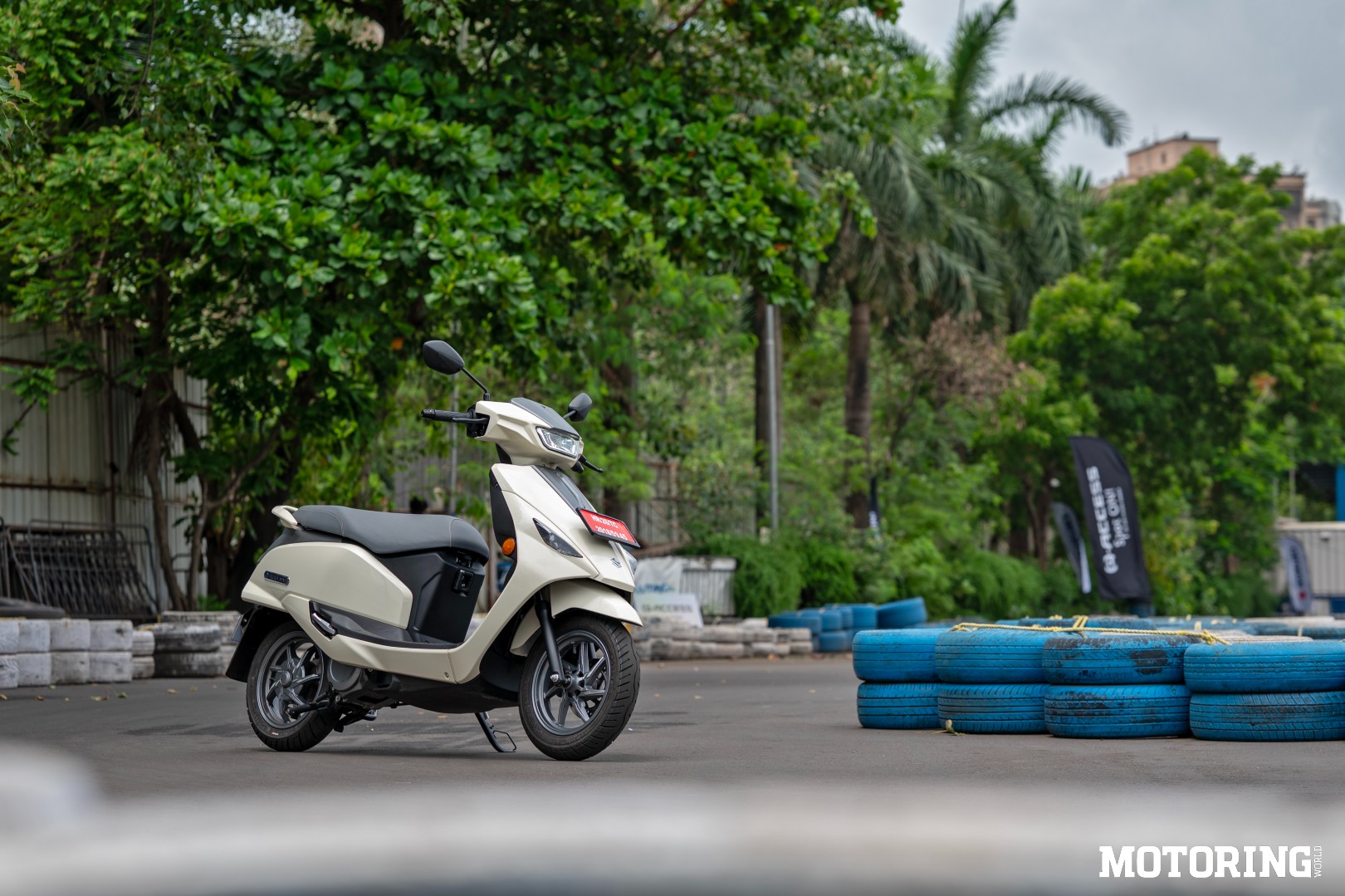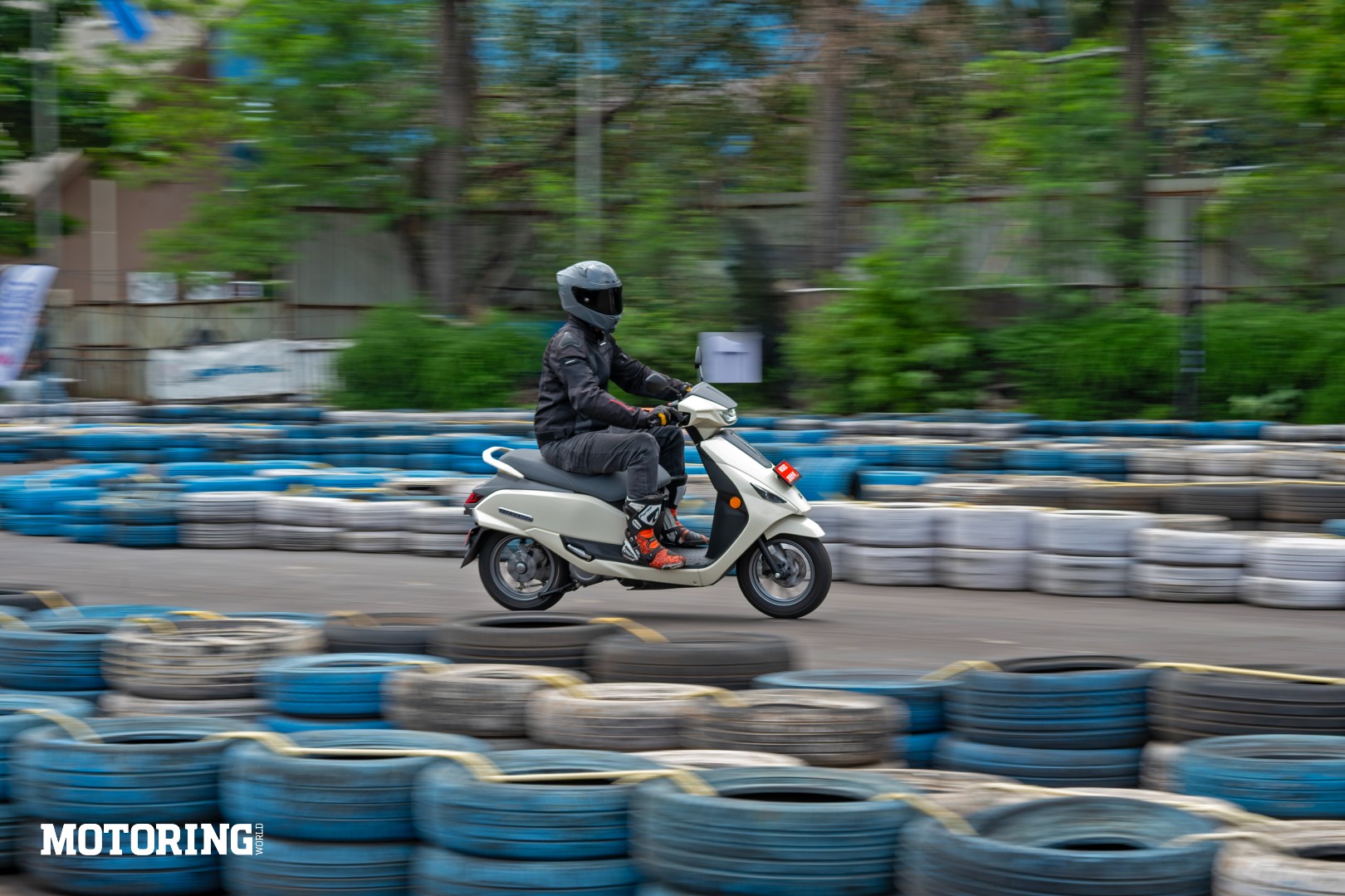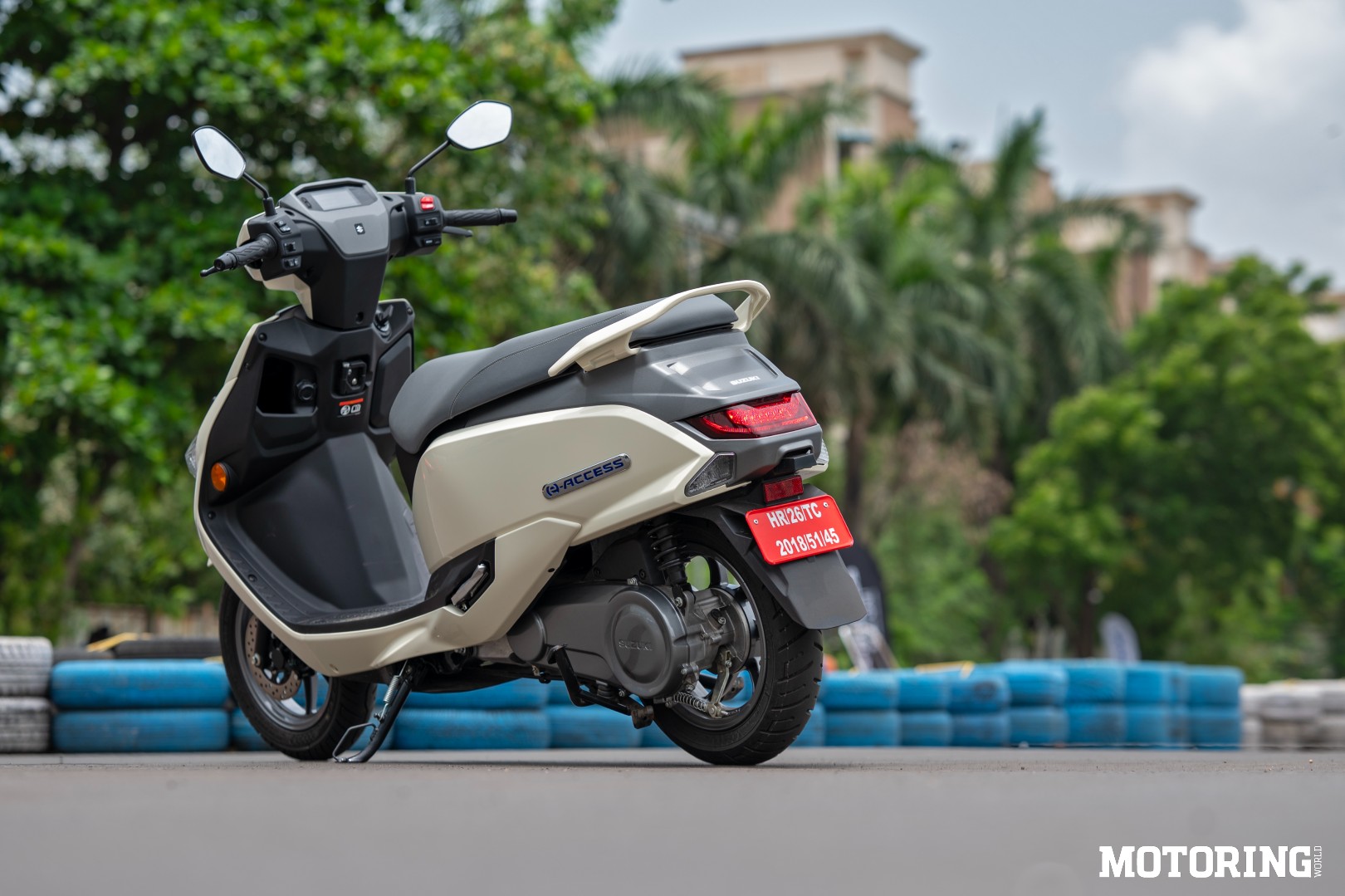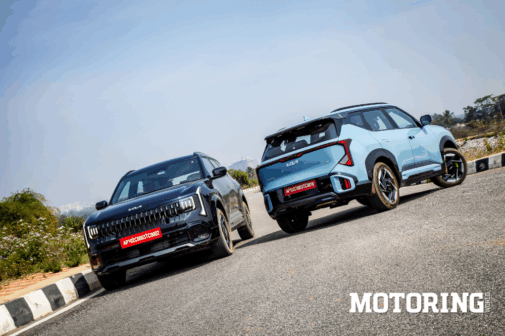A puncture, harrowing traffic, and an hour-long cab ride with a drowsy driver later, I finally reached the hotel — only to find that I’d missed the briefing. Before I could catch my breath, I was whisked away onto a bus for yet another long commute, this time to a go-kart track to experience the Suzuki e-Access. Riding scooters — even the electric ones — on a track wasn’t entirely new to me, but it still felt like an odd setting for a family scooter. Then again, its fuel-sipping petrol counterpart did earn a reputation as a bit of a sleeper. Maybe this one will, too.
Before we hit the track, we were given a demonstration on how to operate the scooter. How hard could it be, right? It’s just a scooter, after all. But I couldn’t have been more wrong. First, the key fob had to be activated by pressing a button and waiting for a green light. Only then would the ring around the multi-function knob glow blue, allowing me to turn the scooter on. After that, it was the familiar brake-and-starter-button combo to get moving — but not before selecting one of two ride modes: Ride Mode A or Ride Mode B. The difference between the two modes was just the level of regenerative braking — Mode A had a stronger (2 kW) regen and Mode B had a milder (1 kW) regen. Suzuki didn’t want the varying regens to take the rider off-guard, so decided to give the option of switching between Eco and one of the Ride Modes but toggling between Ride A and B required a complete stop.
I started off in Eco to get familiar with the track and intended to use Ride Mode B after that and progress to Ride Mode A towards the end. To ‘replicate the Indian roads’, Suzuki placed two speed breakers at the pit exit… thankfully, the track wasn’t dug up nor did we have jaywalkers to add to this simulation’s authenticity. But going over those bumps gave an impression that the rear shock’s rebound was a bit too quick — that said, this was a concern for another day. On the track, it was just about right to handle the task at hand — which was going as fast as I could on a 400-m go-kart circuit.
The layout kept me from testing the top speed of the e-Access, which is claimed to be 55 kph in Eco and 71 kph for other two modes. What this track allowed, though, was a chance to test the acceleration. Of course, keeping its ‘family-first’ personality in mind, the acceleration wasn’t wild, but just enough to keep me entertained — even in Eco.
While initial acceleration in Eco was a bit sluggish, it still felt adequate for real-world use. Switching to Ride Mode B made acceleration feel punchier, but at the cost of regen — the e-Access coasted along almost too smoothly, which meant relying more on the brakes. A few laps later, I pulled into the pits, toggled to Ride Mode A, and went back out. This mode brought out the e-scooter’s bratty side. While acceleration remained the same as Mode B, the stronger regen let me ease off the brakes significantly.
Okay, the e-Access didn’t have the flickable, sharp handling of something like an Ather. You couldn’t throw it from corner to corner with abandon. Instead, it felt composed — sometimes overly so — gliding through corners like a poised figure skater. Of course, lap times and apex precision aren’t top priorities for a family scooter, but it handled the track exercise well enough. The 12-inch wheels offered decent confidence, encouraging me to push the e-Access just outside its comfort zone. The brakes kept up, too. In fact, despite the CBS, I could lock up the rear wheel fairly easily (which, admittedly, I enjoyed), though I doubt the intended audience will feel the same way.
That audience may also raise eyebrows at the 17-litre underseat storage — especially when rivals offer nearly double that. The packaging challenge is down to the battery placement: a 3.027-kWh pack sits directly beneath the rider’s seat, eating up most of the space. That said, the floorboard space is generous, and there’s even a footrest area behind the apron — a bit like a maxi-scooter. With my feet stretched out, it was so comfortable I instinctively switched to Eco mode and just cruised for a lap.
Even when seated like I would be on any regular scooter, the ergonomics were spot-on for my 5’11” frame. The handlebar wasn’t too narrow or too low, and nothing fouled with my knees during tight turns or U-turns. It was bliss. But then again, it had to be — it wears the Access badge, after all.
And that also meant the styling had to be… safe? The e-Access seems caught between showing off its modern EV side and staying loyal to the Access’s neutral, retro-ish vibe. Elements like the LED DRL bar on the apron and the flared side panels housing the indicators add a modern touch, but they do stand out against the otherwise subtle design. And yes, comparisons to the TVS Scooty Pep+’s apron are totally fair. While the scooter’s overall fit-and-finish is commendable, the key fob feels plasticky and a bit cheap in comparison.
With no official word on pricing, charging costs, or real-world range, it’s tough to pass a final verdict on the e-Access. Still, with its composed handling, quality construction, and approachable design, it builds a solid case for itself. That said, considering how its fellow Japanese rival priced its last electric scooter, it’s probably wise to wait until Suzuki puts all its cards on the table.





